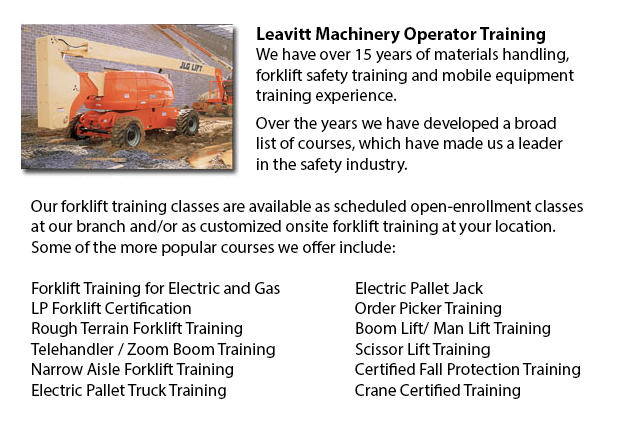
Hamilton Aerial Boom Lift Training - Aerial Boom Lift Training is required for anybody who operates, supervises or works near boom lifts. This kind of aerial lift or aerial work platform is used for lifting individuals, tools and materials in projects requiring a long reach. They are normally used to access utility lines and other above ground job-sites. There are various types of aerial booms lifts, like cherry pickers, articulating boom lifts and extension boom lifts. There are two types of boom lift: "knuckle" and "telescopic".
Training in the essential safety, operations and equipment matters involved in boom lifts is important. Employees should know the rules, dangers, and safe work practices when working amongst mobile machinery. Training program materials offer an introduction to the terms, uses, concepts and skills essential for employees to obtain competence in boom lift operation. The material is aimed at safety professionals, workers and machine operators.
This training is educational, adaptive and cost-effective for your business. An effective and safe workplace can help a company attain overall high levels of production. Less workplace incidents occur in workplaces with strict safety policies. All machine operators should be trained and assessed. They require knowledge of present safety measures. They have to understand and adhere to rules set forth by the local governing authorities and their employer.
Employers should ensure that their employees who operate aerial boom lifts get proper training in their safe use. Operator certification is needed on every different type of aerial machine utilized in the workplace. Certifications are offered for aerial work platforms, articulating booms, industrial forklift trucks, scissor lifts, and so on. Fully trained workers work more efficiently and effectively than untrained employees, who need more supervision. Correct instruction and training saves resources in the long run.
Training is the best prevention for the main causes of workplace fatalities: falls, electrocutions and collapses or tip overs. Other than training, the best way to avoid workplace accidents is to maintain and operate aerial work platforms according to the instructions of the manufacturer. Allow for the total weight of the materials, worker and tools when following load limits. Never override hydraulic, mechanical or electrical safety devices. Employees should be securely held in the basket with a body harness or restraining belt with a lanyard attached. Do not move lift equipment when employees are on the elevated platform. Employees must be careful not to position themselves between the basket rails and joists or beams in order to prevent being crushed. Energized overhead power lines must be at least 10 feet away from the lift equipment. It is recommended that employees always assume wires and power lines may be energized, even if they are down or seem to be insulated. If working on an incline, set brakes and use wheel chocks.
-
Hamilton Aerial Platform Training
Hamilton Aerial Platform Training - Aerial hoists are able to accommodate various odd jobs involving high and hard reaching spaces. Often utilized to perform routine repair in structures with high ceilings, prune tree branches, hoist heavy shelving u... More -
Hamilton Heavy Equipment Operator Certification
Hamilton Heavy Equipment Operator Certification - The heavy equipment operator is a person who manipulates the controls and drives different kinds of big machinery. Heavy machinery is most commonly utilized on construction sites to deliver supplies t... More -
Hamilton Scissor Lift Ticket
Hamilton Scissor Lift Ticket - Scissor lifts have greatly benefited construction operations in view of the fact that the job that used to require much effort and lots of people, can now be completed utilizing the scissor lift truck and only one indiv... More -
Hamilton Forklift Certification Courses
Hamilton Forklift Certification Courses - Forklift certification courses really help to make sure that businesses utilizing forklifts, comply with the regional and local rules. The drivers of the forklift should undergo forklift certification prior t... More -
Hamilton Forklift Training Program
Hamilton Forklift Training Program - The forklift is a common powered industrial vehicle which is in wide use these days. They are occasionally called jitneys, hi los or lift trucks. A departments store would use the forklift to unload and load merch... More -
Hamilton Forklift License
Hamilton Forklift License - Obtaining a forklift license or forklift certification in North America would require the trainee to do hands-on training in addition to classroom instruction. The state, provincial and federal regulatory bodies are respon... More -
Hamilton Manlift Operator Certification
Hamilton Manlift Operator Certification - Our aerial lift and scissor platform training and certification empowers participants with a general understanding and knowledge of the efficient and safe use of "Power Operated Mobile Work Platforms," under... More -
Hamilton Forklift Operator Certification
Hamilton Forklift Operator Certification - Forklift operator certification is usually needed for employees working in industrial, warehouse or construction setting to guarantee the safe utilization of forklifts. Workplace training has to follow a met... More

Forklift Certification Hamilton
TOLL FREE: 1-888-254-6157
Hamilton, Ontario
forkliftcertificationhamilton.com
Email Us
About Us


